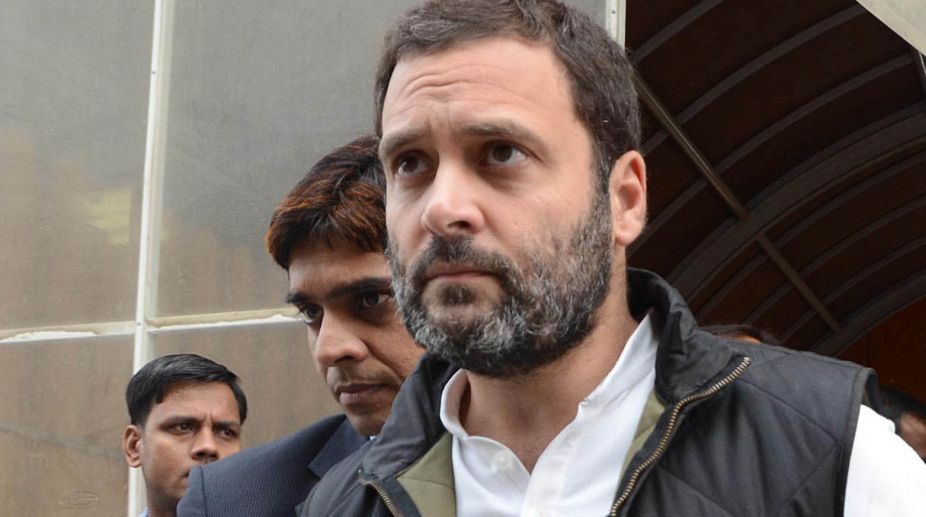Left not afraid of jail unlike Congress: Kerala CM’s counters to Rahul’s remark
The Congress leader had wondered why the Central agencies had not questioned Pinarayi Vijayan despite multiple corruption charges being levelled against him

Rahul Gandhi (Photo: SNS)
One might wonder why Congress Vice-President Rahul Gandhi was on a two-week image projection tour to the US this month but it was with a design. Rahul got some good and bad publicity both in India and the US.
The pro-Congress media claimed that he managed to impress experts in various fields with his candid opinions and views; the anti-Congress media and social media ridiculed his faux pas, such as his controversial remarks on dynastic politics. Gandhi claimed that dynastic politics was part of Indian society, citing examples from politics, films, sports and business. This was contrary to what he had been saying on the issue.
There is a reason behind Rahul’s first major political tour of the US at this point of time. The Congress plans to project Rahul as an alternate to Prime Minister Modi in the 2019 Lok Sabha polls. This was in contrast to 2014 when the Congress did not project any one. Rahul himself admitted that he was ready to be the prime ministerial candidate. Interestingly, he chose to declare his candidature from foreign soil rather than from India.
Advertisement
“I am absolutely ready to do that,” he said at the University of California, Berkeley, when asked if he was ready to be the prime ministerial candidate of the Congress. Rahul is not new to the US, as he has been visiting often. But this was the first time he was projected abroad as a serious prime ministerial contender. This trip was planned well in advance. Sam Pitroda, the chairman of the Congress overseas department and a friend of the Gandhi family admitted, “RG visit was planned several months ago to get right people and platform to optimise consultation process.” What he did not state was that it was an exercise to re-launch the Gandhi scion from the US before he takes control of the party later this year.
Rahul obviously wanted to familiarise himself with American opinion makers and members of the administration as well as engaging with the Indian Diaspora. Secondly, the Congress seems to have realised belatedly that even a young party like the Aam Aadmi Party and of course the BJP have a lot of support from the Indian Diaspora while the Congress lags behind. Rahul’s visit was meant to activate the overseas Congress, which is almost defunct.
“Overseas Indians wield considerable influence in the American establishment and in India. It is, therefore, important to connect with them,” Congress chief spokesperson Randeep Surjewala pointed out.
Though BJP is far ahead of the Congress in its engagement with the Diaspora in the US and elsewhere, one cannot fault Rahul for making a beginning. While addressing the Indian Diaspora at Times Square in New York, the Congress leader said, “Divisive politics are ruining India’s reputation abroad and NRIs in the tradition of the great NRIs before them should stand up to those dividing India now.”
Gandhi struck the right note in his interactions with university students and academics both at Berkeley and Princeton. He spoke about his vision for India, the problems facing India, demonetisation, job loss, intolerance, disharmony and political polarisation. He defended the philosophy of non-violence and also praised India’s diversity and plurality. But what was lacking was that while he criticised the Modi government, he did not indicate what kind of narrative the Congress would offer for voters.
Rahul also did not indicate how he plans to make the party poll-ready. Rahul had a packed programme. He attended Round Table conferences with eminent Indians and South Asia experts, hosted by the Democratic think tank, Center for American Progress. He had another closed-door meeting co-hosted by Republican strategist Puneet Ahluwalia and the American Foreign Policy Institute.
At the White House he interacted with Lisa Curtis, who heads the South Asia division at the National Security Council and he gave his inputs on Indo-US relations and Afghanistan policy. But he did not meet top administration officials or law makers. He had an interaction with the US India Business Council and also the Washington Post editorial Board. At the end of the visit, he repeated his theme on intolerance.
“I had lots of conversations in my trip. I met lot of people from the administration, I met people from both Democratic and Republican parties, and I met many friends, NRI friends. And I must tell you; I was very surprised because before I could even tell them what I was feeling, before I could even tell them what I was worried about, they told me exactly the same thing. And the single biggest thing most people told me, what has happened to the tolerance that used to prevail in India?”
By and large while Rahul might have raised his political profile in the US, the real job is back home where elections are scheduled in Gujarat and Himachal Pradesh soon. It is a question mark whether he will be able to sustain the goodwill he has earned abroad as speeches and tours are not enough.
What he needs to do is to build the organisation, boost the morale of workers and find the right people for the right job. Another defeat in the ensuing polls will demoralise the Congress workers.
Advertisement